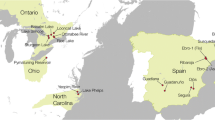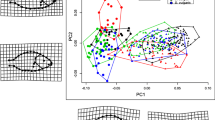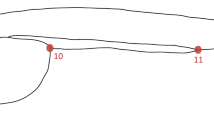Abstract
Contemporary evolution has been shown in a few studies to be an important component of colonization ability, but seldom have researchers considered whether phenotypic plasticity facilitates directional evolution from the invasion event. In the current study, we evaluated body shape divergence of the New Mexico State-threatened White Sands pupfish (Cyprinodon tularosa) that were introduced to brackish, lacustrine habitats at two different time in the recent past (approximately 30 years and 1 year previously) from the same source population (saline river environment). Pupfish body shape is correlated with environmental salinity: fish from saline habitats are characterized by slender body shapes, whereas fish from fresher, yet brackish springs are deep-bodied. In this study, lacustrine populations consisted of an approximately 30-year old population and several 1-year old populations, all introduced from the same source. The body shape divergence of the 30-year old population was significant and greater than any of the divergences of the 1-year old populations (which were for the most part not significant). Nonetheless, all body shape changes exhibited body deepening in less saline environments. We conclude that phenotypic plasticity potentially facilitates directional evolution of body deepening for introduced pupfish populations.



Similar content being viewed by others
References
Adams DC (2004) Character displacement via aggressive interference in Appalachian salamanders. Ecology 85:2664–2670
Adams DC, Collyer ML (2007) The analysis of character divergence along environmental gradients and other covariates. Evolution 61:510–515
Adams DC, Rohlf FJ (2000) Ecological character displacement in Plethodon: biomechanical differences found from a geometric morphometric study. Proc Natl Acad Sci USA 97:4106–4111
Adams DC, Rohlf FJ, Slice DE (2004) Geometric morphometrics: ten years of progress following the ‘revolution’. Ital J Zool 71:5–16
Adams DC, West ME, Collyer ML (2007) Location-specific sympatric morphological divergence as a possible response to species interactions in West Virginia Plethodon salamander communities. J Anim Ecol 76:289–295
Bedrick EJ, Tsai C (1994) Model selection for multivariate regression in small samples. Biometrics 50:226–231
Bookstein FL (1991) Morphometric tools for landmark data: geometry and biology. Cambridge University Press, New York
Claridge K, Franklin SB (2002) Compensation and plasticity in an invasive plant species. Biol Invas 4:339–347
Collyer ML (2003) Ecological morphology of the White Sands pupfish (Cyprinodon tularosa) PhD thesis, North Dakota State University, Fargo
Collyer ML, Adams DC (2007) Analysis of two-state multivariate phenotypic change. Ecology 88:683–692
Collyer ML, Novak JM, Stockwell CA (2005) Morphological divergence of native and recently established populations of white sands pupfish (Cyprinodon tularosa). Copeia 2005:1–11
Deacon J, Deacon-Williams C (1991) Ash Meadows and the legacy of the Devil’s Hole Pupfish. In: Minckley WL, Deacon J (eds) Battle against extinction. The University of Arizona Press, Tucson, pp 69–87
Dybdahl MF, Kane SL (2005) Adaptation versus phenotypic plasticity in the success of a clonal invader. Ecology 86:1592–1601
Hood GM (2005) Poptools, version 2.6.6. Available on the internet (online access: http://www.cse.csiro.au/poptools)
Huey RB, Gilchrist GW, Carlson ML, Berrigan D, Serra L (2000) Rapid evolution of a geographic line in size in an introduced fly. Science 287:308–309
Klingenberg CP, Leamy LJ (2001) Quantitative genetics of geometric shape in the mouse mandible. Evolution 55:2342–2352
Losos JB, Creer DA, Glossip D, Goellner R, Hampton A, Roberts G, Haskell N, Taylor P, Ettling J (2000) Evolutionary implications of phenotypic plasticity in the hindlimb of the lizard Anolis sagrei. Evolution 54:301–305
Losos JB, Schoener TW, Warheit KI, Creer DA (2001) Experimental studies of adaptive differentiation in Bahamian Anolis lizards. Genetica, 112–113
Maron JL, Vilà M, Bommarco R, Elmendorf S, Beardsley P (2004) Rapid evolution of an invasive plant. Ecol Monogr 74:261–280
Miller RR (1948) The cyprinodont fishes of the Death Valley system of eastern California and southwestern Nevada. Misc Publ Museum Zool Univ Mich 1–155
Miller RR (1981) Coevolution of deserts and pupfishes (genus Cyprinodon) in the American Southwest. In: Naiman RJ, Soltz DL (eds) Fishes in North America. Wiley, New York, pp 39–94
Miller RR, Echelle AA (1975) Cyprinodon tularosa, a new cyprinodontid fish from the Tularosa Basin, New Mexico. Southwest Nat 19:365–377
Pigliucci M (2003) Phenotypic integration: studying the ecology and evolution of complex phenotypes. Ecol Lett 6:265–272
Pittenger JS, Springer CL (1999) Native range and conservation of the White Sands pupfish (Cyprinodon tularosa). Southwest Nat 44:157–165
Rice W.R (1989) Analyzing tables of statistical tests. Evolution 43:223–225
Rohlf FJ (2002) NTSYS-pc, version 2.11a. Exeter Software, New York
Rohlf FJ (2004) TPS software. State University of New York, Stony Brook, N.Y.
Rohlf FJ, Marcus LF (1993) A revolution in morphometrics. Trends Ecol Evol 8:129–132
Rohlf FJ, Slice DE (1990) Extensions of the Procrustes method for the optimal superimposition of landmarks. Syst Zool 39:40–59
SAS Institute, Inc (2002) JMP version 5.0.1. SAS Institute, Cary, N.C.
Schmitz DC, Simberloff C, Hofstetter RH, Haller W, Sutton D (1997) The ecological impact of nonindigenous plants. In: Simberloff C, Scnmitz DC, Brown TC (eds) Strangers in paradise. Island Press, Washington D.C., pp 221–228
Simberloff D, Dayan T, Jones C, Ogura G (2000) Character displacement and release in the small Indian mongoose, Herpestes javanicus. Ecology 81:2086–2099
Spector T, Putz FE (2006) Biomechanical plasticity facilitates invasion of maritime forests in the southern USA by Brazilian pepper (Schinus terebinthifolius). Biol Invas 8:255–260
Stockwell CA, Leberg PL (2002) Ecological genetics and the translocation of native fishes: emerging experimental approaches. West N Am Nat 62:32–38
Stockwell CA, Mulvey M (1998) Phosphogluconate dehydrogenase polymorphism and salinity in the White Sands pupfish. Evolution 52:1856–1860
Stockwell CA, Weeks SC (1999) Translocations and rapid evolutionary responses in recently established populations of western mosquitofish (Gambusia affinis). Anim Conserv 2:103–110
Stockwell CA, Mulvey M, Jones AG (1998) Genetic evidence for two evolutionarily significant units of White Sands pupfish. Anim Conserv 1:213–226
Stockwell CA, Hendry AP, Kinnison MT (2003) Contemporary evolution meets conservation biology. Trends Ecol Evol 18:94–101
Thompson, D’Arcy W (1917) On growth and form. Cambridge University Press, Cambridge
Videler JJ (1993) Fish swimming. Fish and fish series 10. Chapman Hall, New York
Vogel S (1994) Life in moving fluids: the physical biology of flow. Princeton University Press, Princeton
Weaver TD (2003) The shape of the Neandertal femur is primarily the consequence of a hyperpolar body form. Proc Natl Acad Sci USA 97:6926–6929
Webb PW (1997) Swimming. In: Evans DH (eds) The physiology of fishes. CRC Press, Boca Raton, pp 3–24
Weihs D, Webb PW (1983) Optimization of locomotion. In: Weihs D, Blake PW (eds) Fish biomechanics. Praeger, New York, pp 339–371
West-Eberhard MJ (2003) Developmental plasticity and evolution. Oxford University Press, New York
West-Eberhard MJ (2005) Phenotypic accommodation: adaptive innovation due to developmental plasticity. J Exp Zool 304:610–618
Acknowledgments
We thank D. Rogowski for assistance with the field collections and fish processing and T. Krabbenhoft for assistance in aging fish. We are grateful to R. Myers (Range Geologist, Environmental Stewardship Division) and T. A. Ladd (Director, Environment and Safety Directorate, US. Army, White Sands Missile Range) for arranging range visitations. Public release of this article was approved by the White Sands Missile Range with distribution unlimited, by Operations Security (OPSEC) review on 18 June, 2003. Laboratory support was provided by Holloman Air Force Base. The research was supported by a US. Department of Defense legacy grant to C.A.S., administered by M.H.R. and a US. Environmental Protection Agency Star Fellowship (U-91597601-1) to M.L.C.
Author information
Authors and Affiliations
Corresponding author
About this article
Cite this article
Collyer, M.L., Stockwell, C.A., Adams, D.C. et al. Phenotypic plasticity and contemporary evolution in introduced populations: evidence from translocated populations of white sands pupfish (Cyrpinodon tularosa). Ecol Res 22, 902–910 (2007). https://doi.org/10.1007/s11284-007-0385-9
Received:
Accepted:
Published:
Issue Date:
DOI: https://doi.org/10.1007/s11284-007-0385-9




